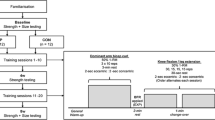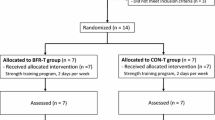Abstract
We examined the effect of 3-week upper limb immobilization on conduit artery cross-sectional area and peak hyperemia (BFpeak) after exhaustive dynamic handgrip exercise (Exdyn), and that of low-volume strength and endurance training during immobilization. Healthy volunteers (n = 21; mean age, 22 years) were divided into 3 groups: immobilization only (IMM; n = 7), immobilization with training (STR + END; n = 7), and control (no immobilization or training, CNT; n = 7). Endurance training comprised Exdyn at 30% maximum voluntary contraction (MVC) (duration of each session, ~60 s; twice weekly). Strength training involved intermittent isometric handgrip exercise at 70% MVC (duration of each session, 40 s; twice weekly), repeated 10 times. We used ultrasound methods to measure the brachial artery cross-sectional area and the BFpeak after Exdyn for 5 min pre- and post-immobilization. We found a significant group by time interaction in BFpeak (p < 0.05). A significant decrease was found in BFpeak in the IMM (p < 0.05) between pre- and post-immobilization and a protective effect in the STR + END. The 3-week upper limb immobilization did not influence the baseline artery cross-sectional area. In conclusion, BFpeak decreased after 3-week upper limb immobilization and a combination of strength training and endurance training preserved the blunted BFpeak.


Similar content being viewed by others
References
Beere PA, Russell SD, Morey MC, Kitzman DW, Higginbotham MB (1999) Aerobic exercise training can reverse age-related peripheral circulatory changes in healthy older men. Circulation 100:1085–1094
Berg HE, Dudley GA, Haggmark T, Ohlsen H, Tesch PA (1991) Effects of lower limb unloading on skeletal muscle mass and function in humans. J Appl Physiol 70:1882–1885
Berg HE, Dudley GA, Hather TB, Tesch PA (1993) Work capacity and metabolic and morphologic characteristics of the human quadriceps muscle in response to unloading. Clin Physiol 13:337–347
Bleeker MW, de Groot PC, Poelkens F, Rongen GA, Smits P, Hopman MT (2005a) Vascular adaptation to 4 weeks of deconditioning by unilateral lower limb suspension. Am J Physiol 288:H1747–H1755
Bleeker MW, Kooijiman M, Rongen GA, Hopman MT, Smits P (2005b) Preserved contribution of nitric oxide to baseline vascular tone in deconditioned human skeletal muscle. J Physiol 565:685–694
Clark BC, Manini TM, Bolanowski SJ, Ploutz-Snyder LL (2006) Adaptations in human neuromuscular function following prolonged unweighting: II Neurological properties and motor imagery efficacy. J Appl Physiol 101:264–272
Clark BC, Hoffman RL, Russ DW (2008) Immobilization-induced increase in fatigue resistance is not explained by changes in the muscle metaboreflex. Muscle Nerve 38:1466–1473
Convertino VA, Doerr DF, Mathes KL, Stein SL, Buchanan P (1989) Changes in volume, muscle compartment, and compliance of the lower extremities in man following 30 days of exposure to simulated microgravity. Aviat Space Environ Med 60:653–658
De Groot PC, Van Kuppevelt DHJM, Pons C, Snoek G, Van Der Woude LH, Hopman MT (2003) Time course of arterial vascular adaptations to inactivity and paralyses in humans. Med Sci Sports Exerc 35:1977–1985
De Groot PC, Poelkens F, Kooijman M, Hopman MT (2004) Preserved flow-mediated dilation in the inactive legs of spinal cord-injured individuals. Am J Physiol 287:H374–H380
Edgerton VR, Zhou MY, Ohira Y, Klitgaard H, Jiang B, Bell G, Harris B, Saltin B, Gollnick PD, Roy RR, Day MK, Greenisen M (1995) Human fiber size and enzymatic properties after 5 and 11 days of spaceflight. J Appl Physiol 78:1733–1739
Ferretti G, Antonutto G, Denis C, Hoppeler H, Minetti AE, Narici MV, Desplanches D (1997) The interplay of central and peripheral factors limiting maximal O2 consumption in man after prolonged bed rest. J Physiol 501:677–686
Fuglevand AJ, Bilodeau M, Enoka RM (1995) Short-term immobilization has a minimal effect on the strength and fatigability of a human hand muscle. J Appl Physiol 78:847–855
Hamaoka T, Katsumura T, Murase N, Kurosawa Y, Shimomitsu T, Kuwamori M, Kagaya A, Chance B (1998) Exercise induced improvement in muscle oxidative function in young females measured by 31phosphorus magnetic resonance spectroscopy (31P-MRS). Jpn J Appl Physiol 28:1–9
Holm L, Reitelseder S, Pedersen TG, Doessing S, Petersen SG, Flyvbjerg A, Andersen JL, Aagaard P, Kjaer M (2008) Changes in muscle size and MHC composition in response to resistance exercise with heavy and light loading intensity. J Appl Physiol 105:1454–1461
Homma T, Hamaoka T, Murase N, Osada T, Murakami M, Kurosawa Y, Kitahara A, Ichimura S, Yashiro K, Katsumura T (2009) Low-volume muscle endurance training prevents decrease in muscle oxidative and endurance function during 21-day forearm immobilization. Acta Physiol 197:313–320
Huonker M, Schmid A, Schmidt-Trucksass A, Grathwohl D, Keul J (2003) Size and blood flow of central and peripheral arteries in highly trained able-bodied and disabled athletes. J Appl Physiol 95:685–691
Jasperse JL, Woodman CR, Price EM, Hasser EM, Laughlin MH (1999) Hindlimb unweighting decreases ecNOS gene expression and endothelium-dependent dilation in rat soleus feed arteries. J Appl Physiol 87:1476–1482
Kamiya A, Iwase S, Sugiyama Y, Mano T, Sudoh M (2000) Vasomotor sympathetic nerve activity in men during bed rest and on orthostasis after bed and on orthostasis after bed rest. Aviat Space Environ Med 71:142–1490
Kamiya A, Michikami D, Shiozawa T, Iwase S, Hayano J, Kawada T, Sunagawa K, Mano T (2004) Bed rest attenuates sympathetic and pressor responses to isometric exercise in antigravity leg muscles in humans. Am J Physiol Regul Integr Comp Physiol 286:R844–R850
Kitahara A, Hamaoka T, Murase N, Homma T, Kurosawa Y, Ueda C, Nagasawa T, Ichimura S, Motobe M, Yashiro K, Nakano S, Katsumura T (2003) Deterioration of muscle function after 21-day forearm immobilization. Med Sci Sports Exerc 35:1697–1702
Matsumura M, Ueda C, Shiroishi K, Esaki K, Ohmori F, Yamaguchi K, Ichimura S, Kurosawa Y, Kime R, Osada T, Murase N, Katsumura T, Hoshika A, Hamaoka T (2008) Low-volume muscular endurance and strength training during 3-week forearm immobilization was effective in preventing functional deterioration. Dyn Med 7:1
McComas AJ (1994) Human neuromuscular adaptations that accompany changes in activity. Med Sci Sports Exerc 26:1498–1509
McCurdy MR, Colleran PN, Muller-Delp J, Delp D (2000) Effect of fiber composition and hindlimb unloading on the vasodilator properties of skeletal muscle arterioles. J Appl Physiol 89:398–405
McDonald KS, Delp MD, Fitts RH (1992) Fatigability and blood flow in the rat gastrocnemius–plantaris–soleus after hindlimb suspension. J Appl Physiol 73:1135–1140
Motobe M, Murase N, Osada T, Homma T, Ueda C, Nagasawa T, Kitahara A, Ichimura S, Kurosawa Y, Katsumura T, Hoshika A, Hamaoka T (2004) Noninvasive monitoring of deterioration in skeletal muscle function with forearm cast immobilization and the prevention of deterioration. Dyn Med 3:2
Mulder ER, Kuebler WM, Gerrits KH, Ritweger J, Stegeman DF, De Haan A (2007) Knee extensor fatigability after bedrest for 8 weeks with and without countermeasure. Muscle Nerve 36:798–806
Overton JM, Woodman CR, Tipton CM (1989) Effect of hindlimb suspension on VO2max and regional blood flow responses to exercise. J Appl Physiol 66:653–659
Rådegran G, Saltin B (1998) Muscle blood flow at onset of dynamic exercise in humans. Am J Physiol 274:H314–H322
Schrage WG, Woodman CR, Laughlin MH (2000) Hindlimb unweighting alters endothelium-dependent vasodilation and ecNOS expression in soleus arterioles. J Appl Physiol 89:1483–1490
Thijssen DH, Ellenkamp R, Kooijman M, Pickkers P, Rongen GA, Hopman MT, Smits P (2007) A causal role foe endtheline-1 in the vascular adaptation to skeletal muscle deconditioning in spinal cord injury. Arterioscler Thromb Vasc Biol 27:325–331
Thijssen DH, Maiorana AJ, O’Driscoll G, Cable NT, Hopman MT, Green D (2010) Impact of inactivity and exercise on the vasculature in human. Eur J Appl Physiol 108:845–875
Tyml K, Mathieu-Costello O, Noble EG (1995) Microvascular response to ischemia, and endothelial ultrastructure, in disused skeletal muscle. Microvasc Res 49:17–21
Tyml K, Mathieu-Costello O, Cheng L, Noble EG (1999) Differential microvascular response to disuse in rat hindlimb skeletal muscles. J Appl Physiol 87:1496–1505
Veldhuizen JW, Verstappen FT, Vroemen JP, Kuipers H, Greep JM (1993) Functional and morphological adaptations following four weeks of knee immobilization. Int J Sports Med 14:283–287
Woodman CR, Sebastian LA, Tipton CM (1995) Influence of simulated microgravity on cardiac output and blood flow distribution during exercise. J Appl Physiol 79:1762–1768
Acknowledgments
The authors are grateful to all the volunteers who participated in this study. This work was supported, in part, by NASDA and a grant-in-aid from the Japanese Ministry of Education, Science, Sports and Culture.
Author information
Authors and Affiliations
Corresponding author
Additional information
Communicated by Susan Ward.
Rights and permissions
About this article
Cite this article
Ohmori, F., Hamaoka, T., Shiroishi, K. et al. Low-volume strength and endurance training prevent the decrease in exercise hyperemia induced by non-dominant forearm immobilization. Eur J Appl Physiol 110, 845–851 (2010). https://doi.org/10.1007/s00421-010-1566-8
Accepted:
Published:
Issue Date:
DOI: https://doi.org/10.1007/s00421-010-1566-8




